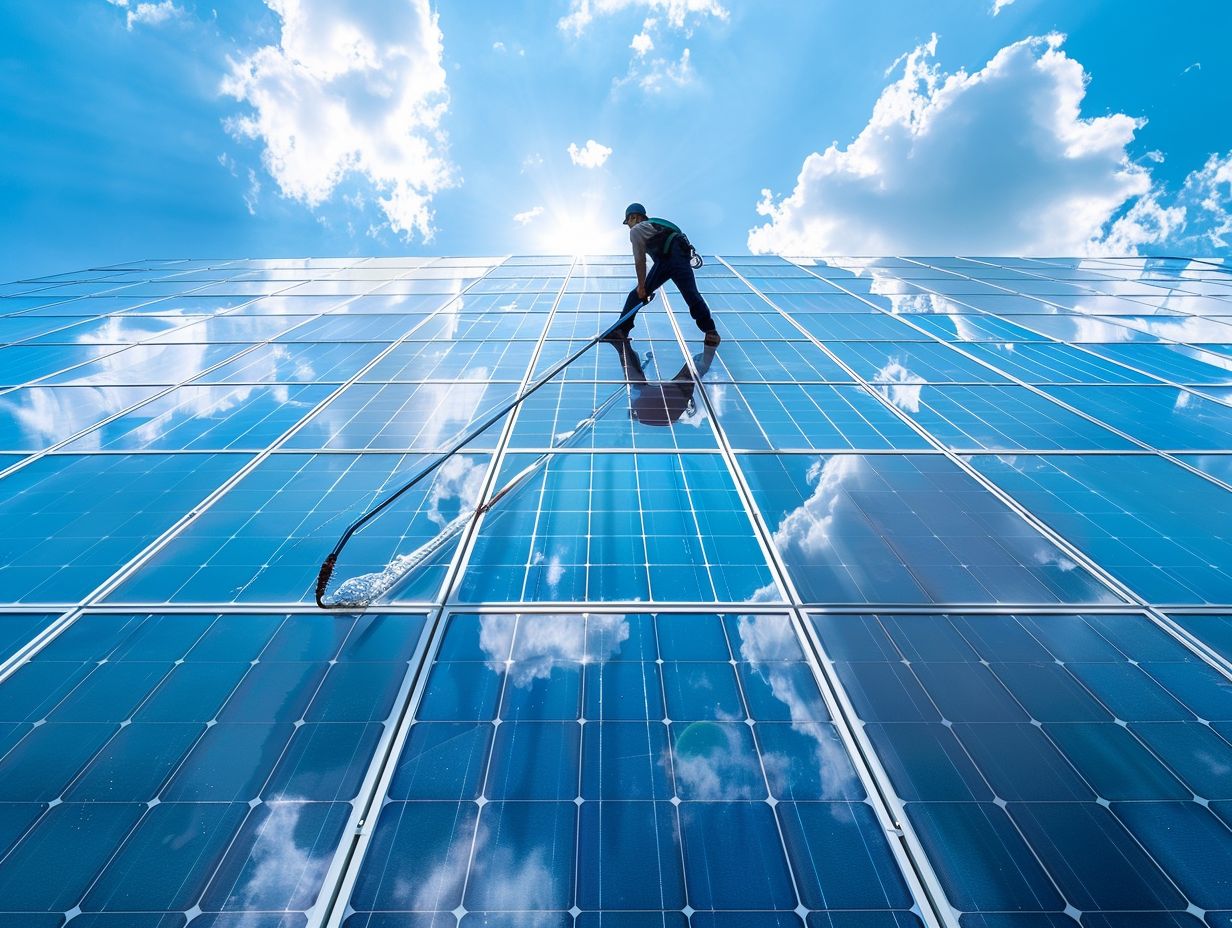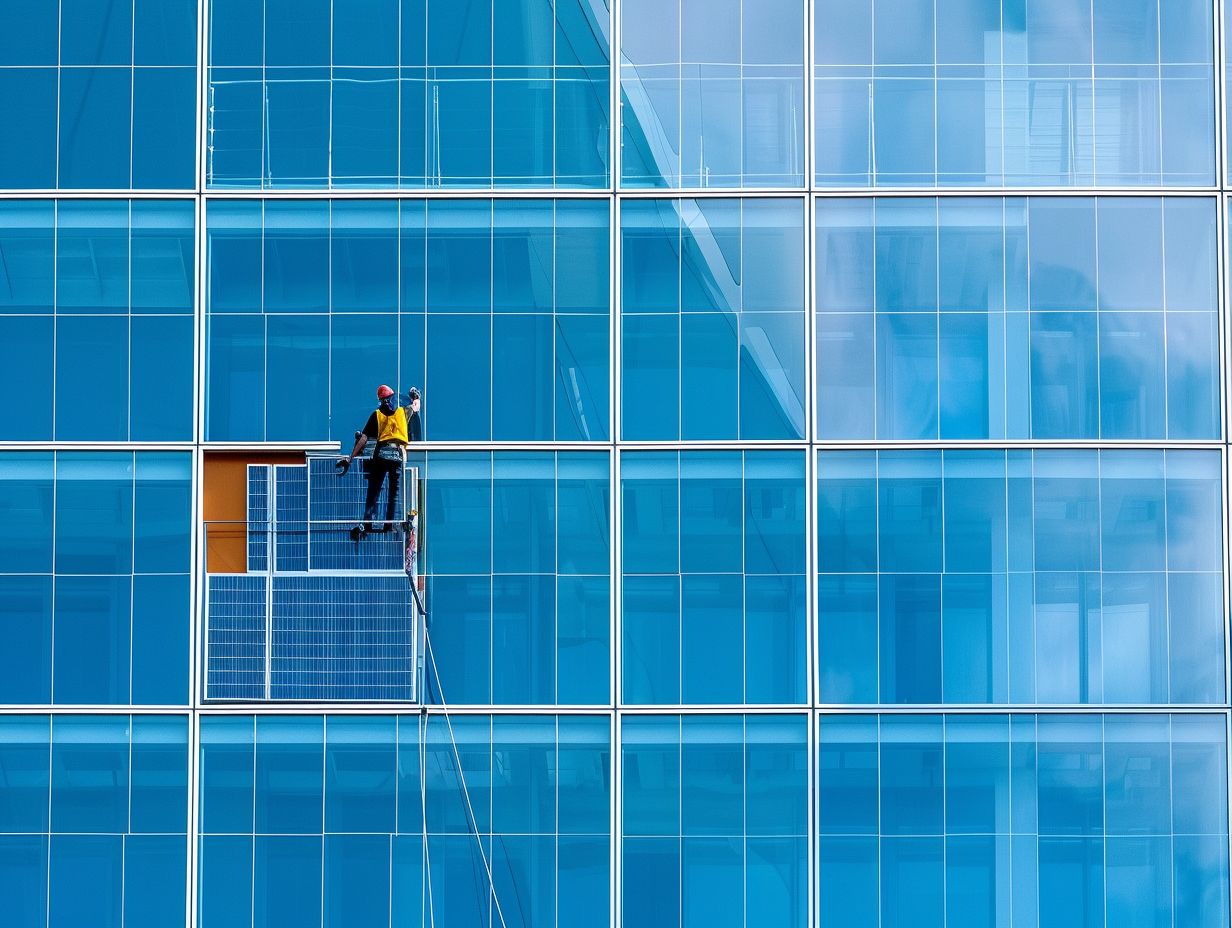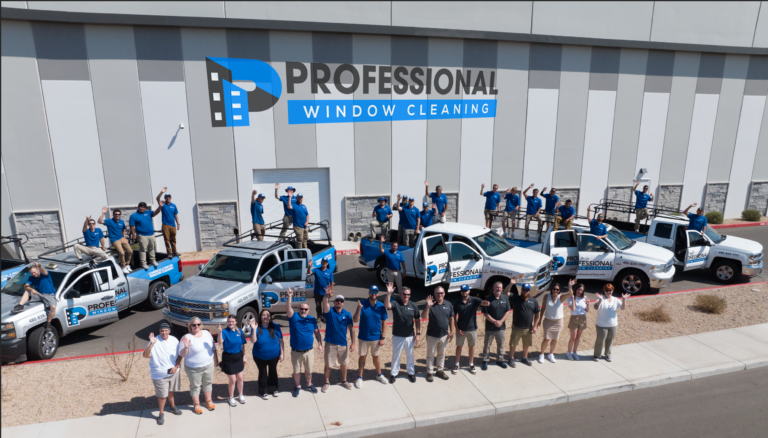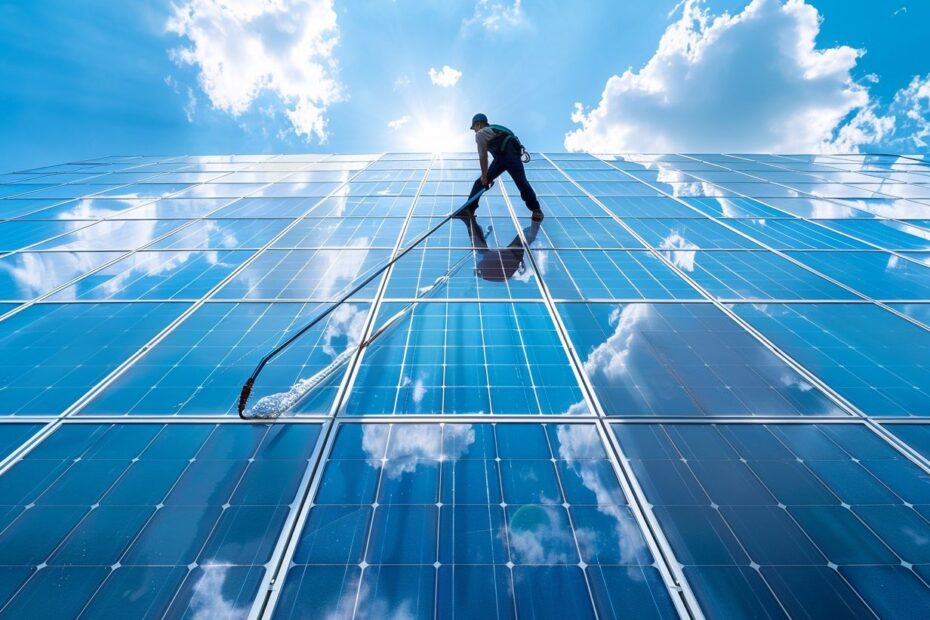Have you ever wondered how solar windows work or what benefits they offer?
We will explore the world of photovoltaic (solar) windows, from their energy-saving properties to their impact on reducing carbon footprints. But it’s not all sunshine and rainbows – cleaning these windows comes with its own set of challenges.
From accessibility issues to the risk of chemical damage, we will discuss how to safely and effectively clean and maintain your solar windows.
Let’s dive in!
What Are Photovoltaic (Solar) Windows?

Photovoltaic (solar) windows are innovative glass surfaces that incorporate solar technology to harness sunlight and convert it into usable energy. These windows act as both traditional building elements and energy-generating assets, providing a dual-purpose functionality in architectural design and energy efficiency.
The structure of photovoltaic windows typically includes multiple layers of material designed to capture and convert sunlight into electricity. The outer layer is made of durable and transparent glass to allow sunlight to penetrate, while the inner layers consist of specialized photovoltaic cells that transform the sunlight into electrical energy. This integrated system enables the building to generate renewable electricity while serving as a functional window.
The working principle of these windows involves the photovoltaic cells absorbing photons from the sunlight, creating an electric current that can be used to power various electrical devices within the building.
How Do Photovoltaic (Solar) Windows Work?
Photovoltaic (solar) windows utilize advanced solar technology embedded within the glass panels to capture sunlight and convert it into electricity. The process involves the photovoltaic cells within the windows absorbing sunlight and generating a direct current, which is then converted into an alternating current for powering electronic devices or feeding into the grid.
These innovative windows are designed to seamlessly integrate into buildings, effectively transforming traditional windows into energy-generating assets. Efficiency factors such as the angle of sunlight exposure, the transparency of the glass, and the material properties play crucial roles in optimizing the energy conversion process.
Performance metrics like the power output per square meter and the overall system efficiency are key indicators of how effectively photovoltaic windows contribute to sustainable energy generation.
What Are the Benefits of Photovoltaic (Solar) Windows?
The benefits of photovoltaic (solar) windows extend beyond energy generation, offering significant advantages such as reduced energy costs, minimized environmental impact through clean energy production, enhanced sustainability in building design, and improved reflection efficiency for optimal performance.
In addition to these benefits, photovoltaic windows play a crucial role in energy savings by harnessing sunlight and converting it into electricity, thereby reducing reliance on traditional power sources. This not only leads to lower electricity bills but also contributes to overall energy efficiency. The use of photovoltaic windows supports sustainable practices by utilizing renewable energy sources, which helps in conserving the environment and reducing carbon footprints. The integration of such innovative technologies in construction also enhances the aesthetic appeal of buildings while promoting an energy-efficient lifestyle.
Energy Savings
Energy savings are a key advantage of utilizing photovoltaic (solar) windows, as they contribute to increased productivity and efficiency in energy output. By harnessing solar power through windows, buildings can reduce their reliance on traditional energy sources, leading to long-term cost savings and improved sustainability.
Photovoltaic windows play a crucial role in enhancing the overall energy efficiency of buildings by capturing sunlight and converting it into electricity. This not only helps in reducing the carbon footprint but also provides a sustainable way to meet the energy demands of modern structures. The integration of photovoltaic windows in building operations can significantly increase the overall energy output, paving the way for a greener and more energy-efficient future.
Reduced Carbon Footprint
The use of photovoltaic (solar) windows contributes to reducing the carbon footprint of buildings by promoting the adoption of clean energy solutions. By generating electricity from sunlight, these windows help mitigate environmental impact, support green energy initiatives, and foster sustainable practices in construction and design.
This shift towards incorporating photovoltaic technology into building structures not only signifies a commitment to reducing reliance on traditional energy sources but also symbolizes a step towards embracing eco-friendly practices.
The installation of solar windows not only reduces operational costs through energy savings but also sets an example for other industries to prioritize environmental conservation.
The alliance between cutting-edge technology and environmentally conscious design sets the stage for a more sustainable future, enabling a shift towards a cleaner, greener, and more sustainable world for generations to come.
Aesthetics
In addition to their energy efficiency benefits, photovoltaic (solar) windows enhance the aesthetics of buildings by seamlessly integrating solar technology into sleek glass surfaces. The innovative design of these windows adds a modern touch to architectural structures, combining functionality with visual appeal.
The incorporation of photovoltaic windows not only generates renewable energy but also elevates the overall look and feel of the building. By merging green technology with design, these windows create a harmonious blend that resonates with the contemporary architectural ethos. Their ability to convert sunlight into electricity without compromising on style makes them a popular choice among architects and designers aiming to achieve a sustainable and visually striking environment.
What Are the Challenges of Cleaning Photovoltaic (Solar) Windows?

Cleaning photovoltaic (solar) windows presents unique challenges due to factors such as accessibility, fragility of the technology, accumulation of dirt and debris, and potential chemical damage. Addressing these challenges effectively is crucial to maintaining the efficiency and performance of solar windows over time.
Regular maintenance is essential to ensure that solar windows operate optimally. Environmental factors, such as weather conditions and air quality, can contribute to the build-up of dirt and pollutants on the surface, hindering sunlight absorption. This reduction in sunlight exposure directly impacts the energy production efficiency of solar panels. Proactive cleaning practices, including scheduled inspections and gentle cleaning methods, can help prevent long-term damage and maximize the lifespan of photovoltaic windows.
Accessibility
Accessibility poses a significant challenge when cleaning photovoltaic (solar) windows, especially in tall or hard-to-reach areas of buildings. Specialized equipment and safety measures are required to ensure that cleaning tasks can be performed effectively and safely at elevated heights.
The use of harnesses, ropes, and scaffolding is common to access these high, often precarious spots, requiring workers to be properly trained and vigilant. The choice of cleaning solutions must take into consideration the effect on the environment and the solar panels themselves. Team coordination and communication are pivotal, as any oversight or error in high-altitude cleaning tasks can result in serious consequences. Incorporating advanced technologies like robotic cleaning systems may also offer safer and more efficient solutions for tackling inaccessible areas.
Fragility
The fragility of photovoltaic (solar) windows presents a risk of equipment damage during cleaning activities. Proper safety measures and caution are essential to prevent any harm to the solar technology embedded within the glass surfaces and maintain the structural integrity of the windows.
These windows, with their intricate technology, are delicate and require gentle handling to avoid accidental breakage or cracks. In addition to safeguarding the solar panels, avoiding scratches and abrasions on the glass surfaces is crucial for optimal energy absorption. It is advisable to use soft, non-abrasive cleaning tools and mild detergents to preserve the efficiency and longevity of the solar windows.
Regular maintenance and adherence to recommended cleaning practices can mitigate the risks associated with cleaning procedures and ensure the sustainable performance of solar window systems.
Dirt and Debris Buildup
Dirt and debris accumulation on photovoltaic (solar) windows can hinder energy production and reduce panel efficiency over time. Implementing effective cleaning routines, dust prevention measures, and regular maintenance schedules are crucial in preventing buildup and ensuring optimal performance of solar windows.
Regular cleaning of solar windows helps maintain their transparency, allowing maximum sunlight penetration for energy conversion. When dirt and debris obstruct the sunlight, the panel’s ability to generate electricity diminishes, impacting the overall efficiency of the system. Minimizing buildup enhances the longevity of the panels, reducing the need for costly repairs or replacements. By incorporating simple cleaning practices and adhering to maintenance schedules, solar panel owners can optimize their energy output and maximize the return on their investment.
Chemical Damage
Chemical damage from improper cleaning solutions can compromise the integrity of photovoltaic (solar) windows, leading to surface damage, pollution residue buildup, and reduced UV protection. Using appropriate cleaning solutions and techniques is essential to avoid harming the solar technology and maintaining the longevity of the windows.
It is recommended to opt for cleaning solutions specifically formulated for solar windows to prevent any chemical reactions that could result in etching or discoloration.
Implementing pollution prevention measures, such as regular cleanings to remove dirt, dust, and grime, can contribute to prolonging the windows’ efficiency.
Considering the detrimental effects of UV exposure on solar panels, incorporating UV protection strategies like applying UV-blocking coatings can shield the windows from sun-induced damage and enhance their performance over time.
How Can You Clean Photovoltaic (Solar) Windows Safely and Effectively?
Cleaning photovoltaic (solar) windows safely and effectively requires the use of non-abrasive materials, avoidance of harsh chemicals, and in some cases, the engagement of professional cleaning services to ensure optimal results. Implementing the right cleaning techniques and solutions is essential to maintain the performance and longevity of solar windows.
When cleaning solar windows, it is crucial to choose cleaning solutions that are specifically formulated for the purpose. Harsh chemicals can damage the glass and coating of solar windows, reducing their efficiency over time.
Non-abrasive materials like soft microfiber cloths or squeegees are gentle on the surface while effectively removing dirt and grime.
Professional cleaning services have the expertise and tools to deep clean solar windows, ensuring they function at their best. Regular maintenance using suitable cleaning methods can significantly improve the energy production of solar panels.
Use Non-Abrasive Materials

When cleaning photovoltaic (solar) windows, it is crucial to utilize non-abrasive materials to avoid scratching or damaging the glass surfaces. Following specific cleaning protocols and using gentle techniques ensure thorough cleaning without compromising the integrity of the solar technology embedded in the windows.
By choosing soft microfiber cloths or squeegees specifically designed for glass cleaning, you can effectively remove dirt, dust, and grime without leaving streaks or residue. It’s also essential to mix a mild detergent or vinegar solution with water to create a safe and effective cleaning solution. When applying the cleaning solution, be sure to use a gentle motion to prevent unnecessary pressure on the glass.
Regularly cleaning solar windows not only enhances the aesthetics of your property but also optimizes the energy efficiency of the solar panels.
Avoid Harsh Chemicals
To protect the integrity of photovoltaic (solar) windows, it is essential to avoid using harsh chemicals that can cause stains or damage the glass surfaces. Opting for gentle cleaning practices and stain removal techniques ensures the effective removal of dirt and debris without compromising the solar windows’ performance.
Harsh chemicals not only leave streaks or residues on the solar windows but can also impact the absorption of sunlight, thereby reducing their efficiency. Utilizing natural cleaners like vinegar and water or specific eco-friendly window cleaning products is highly recommended. When dealing with tough stains, a mixture of baking soda and water can work wonders. Regularly cleaning the windows with a soft cloth or sponge helps maintain their cleanliness and transparency, allowing maximum sunlight penetration for optimal energy generation.
Hire a Professional
For complex cleaning tasks or instances where safety is a concern, hiring a professional cleaner experienced in handling photovoltaic (solar) windows is recommended. Professional cleaners ensure high-quality workmanship, adherence to safety standards, and optimal cleaning outcomes for maintaining solar window efficiency.
They have the expertise to tackle the unique requirements of solar windows, such as using non-abrasive cleaning agents to prevent scratches on delicate surfaces. Their specialized knowledge allows them to identify and address any issues that may affect the functionality of solar panels.
Professional cleaners follow industry best practices to ensure thorough cleaning, removing dirt and debris that may reduce the effectiveness of solar panels. By entrusting the cleaning of solar windows to professionals, you can rest assured that the job will be done efficiently and safely, maximizing the benefits of clean solar panels.
What Are Some Tips for Maintaining Clean Photovoltaic (Solar) Windows?
To keep photovoltaic (solar) windows in optimal condition, regular maintenance practices such as routine cleaning, timely debris removal, and adherence to manufacturer’s instructions are essential. Conducting regular inspections and following a structured maintenance schedule are key to ensuring the longevity and performance of solar windows.
By incorporating these simple yet effective practices into your solar window care routine, you can prevent dirt and grime buildup, ensuring maximum sunlight absorption and energy production. Prompt removal of leaves, bird droppings, and other debris can prevent potential damage and obstructions to the solar panels.
Investing time in regular visual checks can help identify any early signs of wear or performance issues, allowing for timely intervention and maintenance. Remember, clean solar windows not only improve efficiency but also enhance the aesthetic appeal of your property!
Regular Inspections
Regular inspections of photovoltaic (solar) windows are vital to identify any signs of dirt accumulation, surface damage, or performance degradation. Incorporating inspections into maintenance routines and following established protocols ensure timely detection of issues and proactive maintenance to uphold solar window efficiency.
These inspections play a crucial role in not only ensuring that the solar windows function optimally but also in extending their overall lifespan. By regularly monitoring the cleanliness of the windows, maintenance teams can prevent the build-up of dirt and grime that could hinder sunlight absorption and decrease energy output. Detecting any damage early on helps in swiftly addressing and resolving issues before they escalate into more significant problems, ultimately saving time and costs in the long run. Adhering to maintenance protocols ensures that the solar windows operate efficiently, meeting their performance expectations and contributing to a sustainable energy system.
Remove Debris and Dirt Promptly
Prompt removal of debris and dirt from photovoltaic (solar) windows is crucial to prevent buildup and maintain panel efficiency. Implementing appropriate cleaning precautions and following a structured cleaning process ensure that dirt accumulation is minimized, preserving the cleanliness and effectiveness of solar windows.
Regularly cleaning solar windows not only enhances their aesthetic appeal but also plays a significant role in optimizing energy production. By promptly removing debris like leaves, dust, and bird droppings, individuals can prevent shading on the panels and ensure maximum exposure to sunlight. It is important to use gentle cleaning tools such as a soft sponge or cloth to avoid scratching the surface of the highly sensitive solar panels. Applying a mild detergent solution and rinsing thoroughly with water can effectively eliminate stubborn grime without damaging the solar windows.
Follow Manufacturer’s Instructions

Adhering to the manufacturer’s instructions for cleaning and maintenance is essential in preserving the performance and longevity of photovoltaic (solar) windows. Following the recommended cleaning procedures and maintenance schedule ensures that the windows remain in optimal condition and operate efficiently over their lifespan.
Proper cleaning not only enhances the aesthetic appeal of the windows but also prevents the accumulation of dirt and debris that could hinder their energy efficiency.
Regular maintenance helps identify and address any potential issues early on, reducing the risk of costly repairs or replacements down the line.
By adhering to these guidelines, one can maximize the benefits of solar windows and contribute to their overall durability and effectiveness in harnessing solar energy.
Frequently Asked Questions
What are the main challenges of cleaning photovoltaic (solar) windows?
The main challenges of cleaning photovoltaic (solar) windows include the delicate nature of the solar panels, the potential use of harsh chemicals, and the need for regular maintenance to ensure maximum efficiency.
How delicate are photovoltaic (solar) windows and why does it matter when cleaning them?
Photovoltaic (solar) windows are very delicate and can easily crack or become damaged if not handled properly. This is important to keep in mind when cleaning them to avoid causing any harm to the panels.
Are there any specific cleaning products or methods that should be used for cleaning photovoltaic (solar) windows?
Yes, it is important to use non-abrasive and non-corrosive cleaning solutions when cleaning photovoltaic (solar) windows. Harsh chemicals can damage the panels and reduce their efficiency.
How often should photovoltaic (solar) windows be cleaned?
It is recommended to clean photovoltaic (solar) windows at least once a year, or more frequently if they are located in an area with high levels of pollution or dust. Regular maintenance is crucial for optimal efficiency.
Can I clean photovoltaic (solar) windows myself or should I hire a professional?
While it is possible to clean photovoltaic (solar) windows yourself, it is recommended to hire a professional who has experience in handling and cleaning solar panels. This will ensure that the panels are not damaged and are cleaned properly.
Are there any safety precautions I should take when cleaning photovoltaic (solar) windows?
Yes, it is important to turn off the solar panels before beginning the cleaning process to avoid any potential electrocution. Additionally, wearing protective gear such as gloves and safety glasses is recommended.





